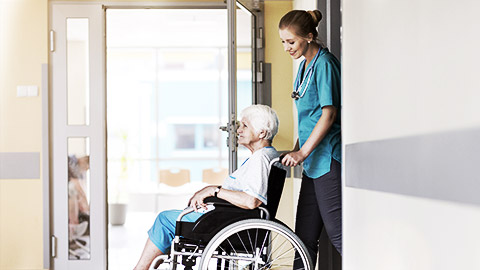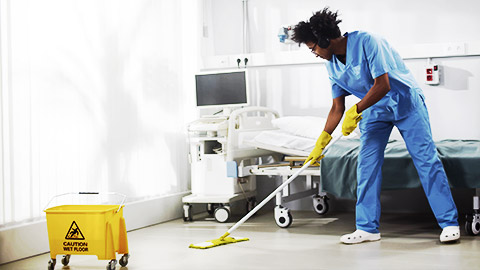In this topic, we will discuss and look at the skills and knowledge required for a worker to participate in safe work practices to ensure their own health and safety and that of others in work environments that involve caring directly for clients.
It has a focus on maintaining the safety of the worker, the people being supported and other community members. We will look at the required skills and knowledge of workplace health and safety (WHS) to carry out work in both centre-based and home-based service provisions applied in accordance with Commonwealth and State/Territory legislation, Australian/New Zealand standards and industry codes of practice.
By the end of this topic, you will understand:
- State and territory workplace health and safety legislation
- Sources of information about workplace health and safety, including policies
- Workplace regulations, codes of practice and industry standards relating to safety
- State and territory WHS authorities
- The WHS rights and responsibilities of employers and workers

Health and safety are the concerns of every person who enters a workplace. Legislation outlines the roles and responsibilities of every Australian employer and worker to protect yourself and others from harm. In the community services workplace, this includes the safety of clients or residents, family members, visitors and volunteers. These laws are made and enforced by different levels of government.
Here are some examples of National Laws and Regulations in Australia:
- The Commonwealth (Australian Government) National work health and safety laws, such as the Workplace Health and Safety Act 2011 (Cwth)
- State and territory governments, State and territory legislation and regulations regarding workplace safety, such as codes of practice
- Local councils and shires Local council bylaws, such as building codes and food safety
Legal Frameworks for Health and Safety Work Health and Safety Legislation
Legal framework means a broad system of rules that governs and regulates decision-making, agreements, laws, etc. As industry standards, service providers have legal and ethical responsibilities toward their clients. This is to ensure that clients consistently receive high-quality and safe support services. This means that both employers and individual support workers must fulfil legal and ethical responsibilities by following safe work practices and as guided by the legislation. A safe workplace is everyone’s right. Workers and employers alike have a role to play in ensuring a workplace is safe. However, employers and workers have quite different responsibilities under the law regarding safety.
The responsibilities of employers include:
- Providing safety equipment (such as PPE) and instruction in its use
- Making sure that the workplace is safe
- Providing training in manual handling and other safety issues
- Acting on incident reports or near-misses.
- Responsibilities of workers include following all reasonable instructions, reporting unsafe situations or practices, and taking reasonable care not to do anything which could put others at risk of harm.
For example: It is highly unethical to abuse and neglect people, and there are laws created against this( eg mandatory reporting for suspected cases of abuse and negligence).
Until 2012, each Australian state and territory had its own act of legislation relating to work health and safety, which could lead to confusion.
The national Workplace Health and Safety Act 2011 (Cwth) (the WHS Act), along with WHS regulations and codes of practice, is referred to as the Model WHS laws. The WHS Act is in place in all states and territories except Victoria and Western Australia. In Victoria, the legislation is called the Occupational Health and Safety Act 2001. In Western Australia, the Occupational Safety and Health Act 1984 provides health and safety legislation. This is likely to change in the future, with WA closer to adopting the Model WHS laws than Victoria.
To help you identify the current WHS legislation covering your project, the table below lists the WHS Act and WHS Regulation of the states and territories of Australia and their respective regulatory body for work health and safety.
The regulations provide guidance around many aspects of working safely, for example around the duty of identifying hazards (Regulation 34), hierarchy of control measures (Regulation 36), duty to provide first aid (Regulation 42), managing risk of hearing loss from noises (Regulation 57), emergency procedures (Regulation 74) in the following state regulations:
- Work Health and Safety Regulation 2011 (ACT)
- Work Health and Safety Regulation 2017 (NSW)
- Work Health and Safety (National Uniform Legislation) Regulations 2011 (NT)
- Work Health and Safety Regulations 2011 (QLD)
- Work Health and Safety Regulations 2012 (SA)
- Work Health and Safety Regulations 2012 (TAS) Safe Work Australia provides national information about safety in the workplace and links to the laws and authorities in each state and territory.
Safe Work Australia provides national information about safety in the workplace and links to the laws and authorities in each state and territory.
Codes of Practice
Codes of practice are generally developed and published by government agencies and authorities such as Safe Work Australia. A code of practice is a booklet or resource written in plain English, and with examples, designed to help you understand an act of legislation. They are often written for particular industries so that the legislation makes sense for the types of tasks you do. In recent years many codes of practice have been replaced with guidance materials. You can find examples of codes of practice on the Safe Work website: ‘Guidance Materials’ website.
State and Territory Health and Safety Authorities
Each jurisdiction in Australia continues to hold its own health and safety authority. The role of these bodies is to:
- Investigate serious workplace accidents
- Visit workplaces to ensure compliance with legislation
- Provide information, education and advice to workplaces about health and safety
- Administer workers compensation schemes.
Here are the health and safety authorities in each state and territory:
Aged care and Disability services are also responsible for maintaining legislation relating to the health and safety issues that are unique to their own industry, contained in various pieces of legislation. The most important of these are the Aged Care Act 1997 (Cwth) and the Disability Act 2006 (Cwth). This legislation contains important health and safety requirements such as preventing and reporting hazards and risks to older people and people with disabilities. They contain legal requirements for performing certain high-risk tasks, such as administering medication. They also outline the different safety roles and responsibilities of workers who are trained at different levels, such as nurses, support workers and volunteers. If your service does not meet this legislation, it can face fines and prosecution.

A standard is written by your industry or sector. In the aged care sector, you must follow the Aged Care Quality Standards. In the disability sector, you must follow the National Disability Service Standards or the NDIS Practice Standards (or both).
There are several areas in the standards that relate to protecting the health and safety of clients and residents, including protecting them from infection and reducing risk of falls and injury.
Failing to meet the standards can lead to your service:
- Receiving a compliance notice to improve
- Facing disciplinary action from a tribunal hearing
- Receiving sanctions on the types of services you are allowed to offer
- In extreme cases, being closed.
You can find the Aged Care Quality Standards and the Guidance materials that will help you to understand how to apply them on the Australian Government’s Aged Care Quality and Safety Commission website.
After reading, find the answers to the following:
- What do the standards say about handwashing for staff and consumers?
- What else do the standards say about your responsibilities for reducing risk to consumers?
Duty of care means acting reasonably to protect others from harm, and to take all reasonable precautions to keep others safe. This includes responding to situations in a way that a reasonable person would be expected to act, given your job role, training and information that you can see or have been given.
You have a duty of care to:
- Follow all policies and procedures
- Help contribute to a safe working environment
- Protect yourself and others from injury wherever possible
- Take reasonable precautions to prevent harm, injury or abuse
- Record and report all accidents and incidents
- Report any problems or concerns.
Watch this video that refer to Fundamentals of Community Services for more about duty of care..
Your workplace will have its own unique set of policies and procedures. These will have many similarities to the policies of other workplaces because policies must be based on different types of legislation and industry requirements, including those outlined above. Policies are generally written by a committee of staff members. They must be easily available to staff, easy to follow and provide you with enough help for you to follow the law. Along with understanding your own role in relation to health and safety policies, everyone in the workplace has a part in helping others, including clients, families, contractors, visitors and other workers to access and understand them. You must model the behaviours and procedures that are expected in the service policies. It is also your responsibility to monitor the safe behaviour of others, including other staff, clients and families, and take steps to ensure that breaches in policies are reported.
Accessing Policies
It is crucial that all staff, volunteers and contractors can access policies and procedures readily. Many policies that relate to clients, residents or families should also be provided or easily accessible to them.
Depending on the service, health and safety policies might be found:
- In folders in your service’s office
- On the organisation’s intranet
- In booklet form and distributed to staff and clients or their families
- On posters or notices on walls to remind staff and others, including clients, of a particular policy, such as washing hands or wearing PPE.
If your service maintains its policies and procedures on an intranet platform, it is helpful to have a hard copy readily available on site as well, as long as it is updated whenever changes are made to the digital version.
Policy Breaches
Not knowing about a policy is never an acceptable excuse for breaching it. Your service must make the policy easy to read and access, but it is your responsibility to read and understand it. If you work outside of policy, your actions can lead to risks to the health and safety of others. It can also mean that your workplace can refuse to support you if claims for negligence, injury or harm are taken against you.
Responsibilities of Employers
Employers must ensure that the health and safety of all people, including clients, volunteers and visitors is not placed at unnecessary risk.
Employers and business owners must maintain all buildings and equipment so that you can perform your own role safely, and to maximise safety to the people you support.
They must supply equipment according to law, such as gloves and other infection control items, machines to help you to transfer people where needed, and other safety items. Your employer must make indoor and outdoor areas secure and as free as possible from hazards that are known to cause injury.
Employers must provide training and information that helps you to perform your job safely. Some of this training, such as manual handling and infection control training, is compulsory according to law. However, you must also be able to ask for help and information for other parts of your role, including the use of new equipment. Employers and managers must also report certain types of incidents to the state or territory safety authority.
Responsibilities of Employees
You must by law take reasonable care of yourself and others at all times.
You must also co-operate with your managers and employer by following policies and attending training. The section that outlines the scope of the policy usually provides information about who is responsible for the requirements of the policy. If you are unsure about the scope of your responsibilities, it is likely that the policy needs updating to make this clearer to you and others. It is far better to seek help with understanding your own role in acting on a policy before you need to respond to a real situation.
In most cases, it is not acceptable to simply leave a health and safety issue to someone else. If you see a hazard, deal with it immediately. If possible, remove the hazard, such as by cleaning a spill, or placing a broken piece of equipment in a locked area to be fixed by maintenance workers.
One of your most important responsibilities is to report and document the problem to a manager or appropriate senior person. Reporting and documentation procedures might vary between services and depend on the level of risk. Reporting can mean verbally reporting to a manager, a senior manager, a maintenance officer or even emergency services such as the police or ambulance. Documentation should include completing an incident report, or an illness or injury report.
Case Study on how little problem can turn into BIG issues

Little problems often become big problems if no one takes the initiative to correct them. If employees don’t bother to report a malfunctioning machine or a slip-and-fall hazard, serious injuries could occur – injuries that could have been preventable.
Although the severity of consequences for failing to report a hazard varies, ignoring any hazard can be detrimental to colleagues, clients, your workplace and your industry.
Consequences can build from one incident that causes an injury to a co-worker. Consider the following ‘snowball effect’ of placing the mop and bucket in the wrong place:
- A staff member trips over a mop and bucket that you or someone else left in the hallway, just out of sight around the corner of a walkway
- That staff member injures their wrist breaking their fall onto the ground.
- The mop and bucket are spilled, and the dirty water has now spread onto the carpet and under the door of a resident’s private room and onto the staff member and yourself
- The staff member needs assistance, and an Ambulance is called
- A clean up of the area is required as a matter of urgency under infection control procedures (the mop and bucket are allocated to the toilets for use ONLY)
- The resident whose room has been affected is very distressed about the smelly, dirty water and is trying to assist you in cleaning it up but it not wearing any PPE and is partially deaf so cannot hear you asking her to step back away from the contaminant
- The residents’ shoes are wet and contaminated now as a result
- The staff member is taken to hospital and now the shift is understaffed
- You and the resident are both contaminated with dirty toilet water and you require assistance to manage the incident, yet there is no staff to assist as it is now dinner time and all are busy assisting the residents with meals and medication… And so it goes on…
Simply doing one any of the following things would have prevented this entire occurrence:
- being mindful and aware of where the mop and bucket were placed
- reporting the mop and bucket location and placing a sign near it as a warning
- relocating the mop and bucket to a safer position
Let's do a quick knowledge check by completing the quiz below before you proceed further.

